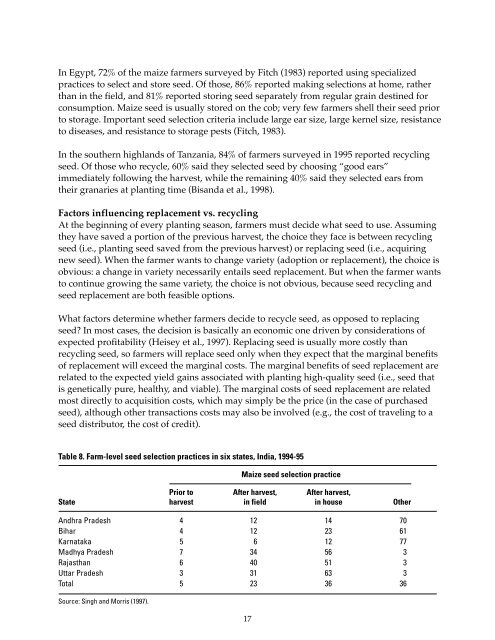A Review of the Evidence - Search CIMMYT repository
A Review of the Evidence - Search CIMMYT repository
A Review of the Evidence - Search CIMMYT repository
You also want an ePaper? Increase the reach of your titles
YUMPU automatically turns print PDFs into web optimized ePapers that Google loves.
In Egypt, 72% <strong>of</strong> <strong>the</strong> maize farmers surveyed by Fitch (1983) reported using specializedpractices to select and store seed. Of those, 86% reported making selections at home, ra<strong>the</strong>rthan in <strong>the</strong> field, and 81% reported storing seed separately from regular grain destined forconsumption. Maize seed is usually stored on <strong>the</strong> cob; very few farmers shell <strong>the</strong>ir seed priorto storage. Important seed selection criteria include large ear size, large kernel size, resistanceto diseases, and resistance to storage pests (Fitch, 1983).In <strong>the</strong> sou<strong>the</strong>rn highlands <strong>of</strong> Tanzania, 84% <strong>of</strong> farmers surveyed in 1995 reported recyclingseed. Of those who recycle, 60% said <strong>the</strong>y selected seed by choosing “good ears”immediately following <strong>the</strong> harvest, while <strong>the</strong> remaining 40% said <strong>the</strong>y selected ears from<strong>the</strong>ir granaries at planting time (Bisanda et al., 1998).Factors influencing replacement vs. recyclingAt <strong>the</strong> beginning <strong>of</strong> every planting season, farmers must decide what seed to use. Assuming<strong>the</strong>y have saved a portion <strong>of</strong> <strong>the</strong> previous harvest, <strong>the</strong> choice <strong>the</strong>y face is between recyclingseed (i.e., planting seed saved from <strong>the</strong> previous harvest) or replacing seed (i.e., acquiringnew seed). When <strong>the</strong> farmer wants to change variety (adoption or replacement), <strong>the</strong> choice isobvious: a change in variety necessarily entails seed replacement. But when <strong>the</strong> farmer wantsto continue growing <strong>the</strong> same variety, <strong>the</strong> choice is not obvious, because seed recycling andseed replacement are both feasible options.What factors determine whe<strong>the</strong>r farmers decide to recycle seed, as opposed to replacingseed? In most cases, <strong>the</strong> decision is basically an economic one driven by considerations <strong>of</strong>expected pr<strong>of</strong>itability (Heisey et al., 1997). Replacing seed is usually more costly thanrecycling seed, so farmers will replace seed only when <strong>the</strong>y expect that <strong>the</strong> marginal benefits<strong>of</strong> replacement will exceed <strong>the</strong> marginal costs. The marginal benefits <strong>of</strong> seed replacement arerelated to <strong>the</strong> expected yield gains associated with planting high-quality seed (i.e., seed thatis genetically pure, healthy, and viable). The marginal costs <strong>of</strong> seed replacement are relatedmost directly to acquisition costs, which may simply be <strong>the</strong> price (in <strong>the</strong> case <strong>of</strong> purchasedseed), although o<strong>the</strong>r transactions costs may also be involved (e.g., <strong>the</strong> cost <strong>of</strong> traveling to aseed distributor, <strong>the</strong> cost <strong>of</strong> credit).Table 8. Farm-level seed selection practices in six states, India, 1994-95Maize seed selection practicePrior to After harvest, After harvest,State harvest in field in house O<strong>the</strong>rAndhra Pradesh 4 12 14 70Bihar 4 12 23 61Karnataka 5 6 12 77Madhya Pradesh 7 34 56 3Rajasthan 6 40 51 3Uttar Pradesh 3 31 63 3Total 5 23 36 36Source: Singh and Morris (1997).17
















